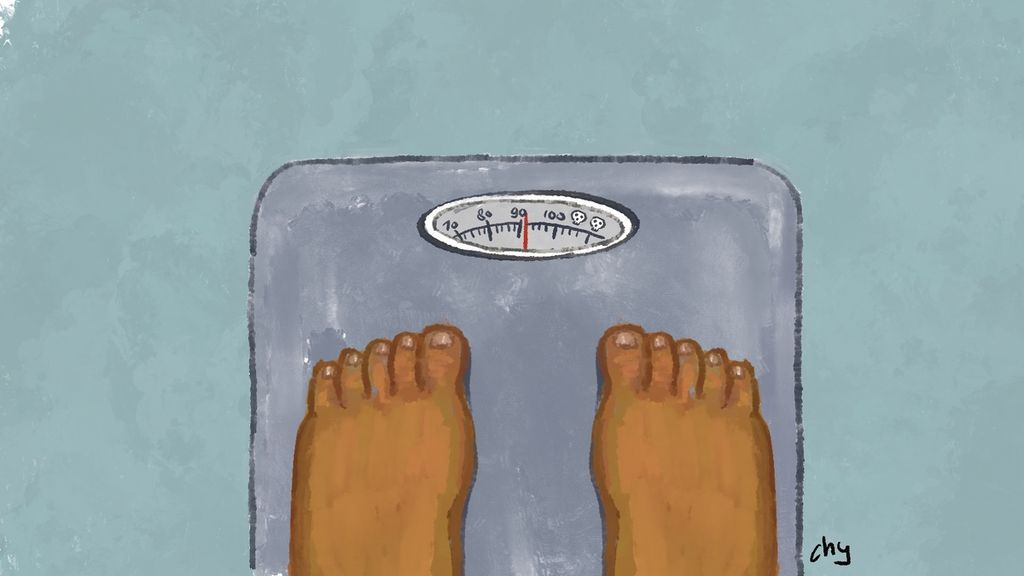Obesity, Contemporary Epidemic
Malnutrition and tengkes programs are common in these countries, while weight management programs are barely heard of. Obesity is a modern epidemic and a big enemy with collateral damage,

In developing countries, the issue of being overweight has not received serious attention. The government and society are more focused and enthusiastic in handling cases related to being underweight, such as malnutrition or tengkes (stunting).
Therefore, malnutrition and tengkes programs are common in these countries, while weight management programs are barely heard of.
In fact, being overweight has developed into a very serious health issue. The impact is real and far-reaching on individuals, communities and countries.
In the coming decades, the magnitude of this impact will shift to developing countries. At present, in many developing countries, being overweight kills more people than being underweight.
In the last few decades, there has been a significant change in the trend of weight issues. Forty years ago, the majority of the world's population was thin and slim. At that time, the prevalence of the underweight population was indeed two times higher than the overweight population. In the course of 40 years, things changed. The proportion of men and women being overweight increased by 200-300 percent, while the proportion of being underweight decreased by 30 percent.
The same trend also occurred among children and adolescents. Compared to 1975, the prevalence of overweight children and adolescents have quadrupled. Because of this, a narrative emerged that the earth was stricken by a contemporary plague, which extremely changed its essence from the world of being underweight to overweight.
Progressive chronic disease
The World Health Organization (WHO) defines being overweight as an excessive accumulation of body fat that is detrimental to health. There are many ways to calculate accumulated body fat, ranging from the simple (such as measuring waist circumference) to the more sophisticated (using DEXA, CT scan or MRI).
The most practical and widely used method is the measurement of the body mass index (BMI). This is a simple calculation that uses weight and height values.
Based on the BMI, individuals are categorized as having an ideal body weight if the BMI is 18.5-24.9, being underweight (below 18.5), being overweight (above 24.9) or obese (30 or more). Some individuals have extreme obesity (morbidly obese) with a BMI value above 40.
At first, being overweight or obese were only considered a problem of negligence in controlling what you eat. Both were not considered a serious problem. In fact, there is a concept “obesity paradox,” which narrates that obesity is not related to health. There are many overweight people that are healthy and conversely, many slim people that are ill.
Over time, views on this condition have changed. Obesity is now considered a risk factor and having the possibility of suffering from other diseases.
Another cause is the obesogenic environment in the form of the presence of fast-food or junk-food stalls, the low prices of high-calorie foods and the sluggishness of physical activity and sports.
In 1998, the United States National Institutes of Health (NIH) issued a statement that obesity is not just a risk factor, but a chronic disease. A similar statement was issued by the American Obesity Society in 2008, followed by the American Medical Association in 2013. Currently, obesity is no longer seen as a weight-gain problem, but a progressive chronic disease with genetic, hormonal, metabolic, psychological, cultural and behavioral aspects.
Several studies report a crucial role of genetics of up to 70 percent. If one parent is obese, the chance that their child will be obese is around 40-50 percent. If both parents are obese, the chance of the child becoming obese increases by 70-80 percent.
Another cause is the obesogenic environment in the form of the presence of fast-food or junk-food stalls, the low prices of high-calorie foods and the sluggishness of physical activity and sports.
The combination of genetics and the obesogenic environment is exacerbated by the disruption of the body's hormonal function due to stress, lack of sleep and the use of drugs, especially psychotropics.
The problem of being overweight or obese has now developed into a global health issue whose impact can be even worse than smoking. The reason is that the global trend of smoking is relatively stable or declining, while the trend of being overweight is actually increasing in almost all countries.

In 2016 alone, it was recorded that nearly two billion of the world population were overweight and 700 million were obese. Of the total world population, 39.5 percent are overweight and 13 percent suffer from obesity. The World Obesity Federation predicts that if serious treatment is not taken, around one billion people, namely one in five women and one in seven men, will become obese before 2030.
Ironically, the magnitude of obesity will shift to developing countries. In the next decade, the obese population in developed countries will increase 1.5 times, while in developing countries it will increase two to three times.
In Indonesia, a similar phenomenon occurs. The issue of obesity and being overweight is increasingly worrying. The 2018 National Health Research showed a doubling of obesity within 10 years.
In 2007, the prevalence was at 19.1 percent, increasing to 35.4 percent in 2018. The total obese population is 70 million; nearly a third of Indonesia's population. In children, obesity is also prevalent. One in five children aged 5-12 years are overweight or obese.
Overweight and obesity are crucial health issues due to their large multidimensional impacts, especially on health, economic and social aspects. Being overweight or obese shortens life. Those suffering from obesity experience a decrease in life expectancy of two to 10 years, depending on their BMI value.
The decrease occurs due to the direct effects of obesity or comorbidities. The morbidity effect is significant. Those who are obese have the potential to suffer and experience aggravation of at least 18 types of diseases, including stroke, heart disease and cancer. This weight is directly proportional to the BMI; the higher the BMI value, the greater the weight.
At the global level, every year, being overweight or obese causes 3.4 million deaths and 4 percent of years of life lost. Even worse, the effects of obesity are greater in Asian populations, including Indonesia. With the same BMI value, individuals from Asia experience a multi-fold increased risk of suffering from diabetes, hypertension and heart disease compared to Caucasian ethnicity.
The economic effect is also very significant. Research in 161 countries reports that health financing related to being overweight or obese is around 3.3 percent of the gross domestic product (GDP). These costs will continue to increase and the largest increase (12-15 times) will occur in developing countries. This fee is required for the purchase of medicines and other treatments.
In the US, obesity-related costs in 2019 amounted to US$173 billion, nearly 15 percent of Indonesia's GDP.
In addition, obese people are prone to experiencing mental health disruptions in the form of motivation and mood disturbances, decreased quality of life and impaired interpersonal communication. At the same time, they are affected by social effects in the form of stigmatization, discrimination, rejection and humiliation. Many of them have difficulty getting a job, especially when it comes to jobs that involve physical activity.
In the US, about a third of young men are unable to enlist in the military because of obesity. The cost of losses due to mental and social effects can be far greater than the direct cost of treating obesity.
Aggressive fight
Although obesity is a frightening specter, there is good news: this condition can be prevented. Crucial key holders are the individuals.
Individuals can avoid or suppress the progression of obesity by doing a few simple things consistently: increase awareness about the dangers of obesity, avoid excessive energy intake from sugar and fat, increase fruit and vegetable consumption, do a physical activity for at least 60 minutes per day for children and 150 minutes per week for adults.
The labeling of disease in obesity signals that obesity is a systemic dysfunction whose management must be comprehensive and cross-sectoral. Individual effort alone is not enough. All stakeholders must be involved in the fight against obesity. The government must be involved by establishing relevant regulations or policies.

For example, requiring warning labels on foods that contain high sugar, calories and fat, limiting advertisements for high-calorie and high-fat foods, national obesity screening and activating the national movement against diabetes with appropriate and feasible programs.
The food industry must be involved by writing down the calorie and fat content on each menu served as well as written messages inviting people to avoid obesity.
At the global level, the WHO has taken a series of steps to reduce obesity, including setting a target that there should be no increase in the prevalence of obesity in the 2010-2025 period. Various countries and institutions, both local and international, have also initiated programs against obesity.
However, it seems that the results have not been satisfactory. The prevalence of obesity continues to rise from year to year. One of the reasons is the lack of awareness that obesity is a chronic and progressive disease, which has the same magnitude as other serious diseases, such as heart disease, stroke and cancer.
In fact, there are still many who think obesity is just a problem of overeating and that obesity is a characteristic of healthy, successful and prosperous people.
In Indonesia, the government launched an action against obesity through the Nusantara Movement to Reduce Obesity Rates (Gentas) program in 2016.
However, this program is more focused on invitations to regulate diet and exercise as well as formal promotions and education activities. There is no national scale movement that shows the government's active and progressive attitude, for example making legislation or setting mandatory warning labels on high-calorie foods.
Gentas’ vision and content are not aggressive enough for the crucial issue of obesity, too simplistic for such an extreme problem. If the fight against obesity is based solely on the Gentas content, it is unlikely that the obesity issue will be handled, let alone eradicated, in this country. The prevalence of obesity will increase. It is necessary to carry out a serious revision of the vision and activities of Gentas.
The fight against obesity in this country must be more aggressive and frontal. It does not only involve standard formal education jargon, but 'forces' to involve the government, health and non-health institutions as well as the food industry in an active and real way.
All stakeholders must share a clear image: obesity is a modern epidemic and a big enemy with collateral damage, which not only causes the disruption of body size due to negligence in controlled eating. World obesity expert Dr. George Bray once said, ”Obesity is not rocket science; it is much more complicated.”
Iqbal Mochtar, Executive Member of the PB IDI and PP IAKMI, Chairman of the Indonesian Doctors Association for the Middle East.
This article was translated by Kurniawan Siswo.